
A hillfort is a type of earthworks used as a fortified refuge or defended settlement, located to exploit a rise in elevation for defensive advantage. They are typically European and of the Bronze Age or Iron Age. Some were used in the post-Roman period. The fortification usually follows the contours of a hill and consists of one or more lines of earthworks, with stockades or defensive walls, and external ditches. Hillforts developed in the Late Bronze and Early Iron Age, roughly the start of the first millennium BC, and were used in many Celtic areas of central and western Europe until the Roman conquest.

A burgstall is a German term referring to a castle of which so little is left that its appearance cannot effectively be reconstructed. It has no direct equivalent in English, but may be loosely translated as "castle site". Variations in the literature include Burgstelle, Altburgstelle, die Burgställe (plural), Burgstähl (archaic) or abgegangene Burg. In German castle studies, a burgstall is a castle that has effectively been levelled, whereas a "ruin" (Ruine) still has recognisable remnants of the original castle above the level of the ground.
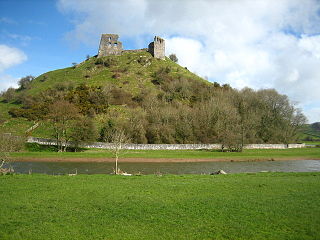
Dryslwyn Castle is a native Welsh castle, sited on a rocky hill roughly halfway between Llandeilo and Carmarthen in Wales. It stands on high ground overlooking the Tywi Valley with extensive views. It was built in about the 1220s by one of the princes of the kingdom of Deheubarth, and changed hands several times in the struggles between the Welsh and English over the ensuing centuries. It is considered one of the most important remaining structures built by a Welsh chieftain and is a Grade I listed building.
Ridgeways are a particular type of ancient road that exploits the hard surface of hilltop ridges for use as unpaved, zero-maintenance roads, though they often have the disadvantage of steeper gradients along their courses, and sometimes quite narrow widths. Before the advent of turnpikes or toll roads, ridgeway trails continued to provide the firmest and safest cart tracks. They are generally an opposite to level, valley-bottom, paved roads, which require engineering work to shore up and maintain. Unmaintained valley routes may require greater travelling distances than ridgeways.

Bergfried is a tall tower that is typically found in castles of the Middle Ages in German-speaking countries and in countries under German influence. Friar describes it as a "free-standing, fighting-tower". Its defensive function is to some extent similar to that of a keep in English or French castles. However, the characteristic difference between a bergfried and a keep is that a bergfried was typically not designed for permanent habitation.
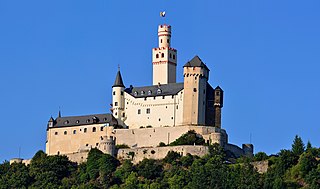
A hill castle or mountain castle is a castle built on a natural feature that stands above the surrounding terrain. It is a term derived from the German Höhenburg used in categorising castle sites by their topographical location. Hill castles are thus distinguished from lowland castles (Niederungsburgen).

Pillnitz Palace is a restored Baroque schloss at the eastern end of the city of Dresden in the German state of Saxony. It is located on the bank of the River Elbe in the former village of Pillnitz. It was the summer residence of many electors and kings of Saxony; it is also known for the Declaration of Pillnitz in 1791.

The term lowland castle or plains castle describes a type of castle that is situated on a lowland, plain or valley floor, as opposed to one built on higher ground such as a hill spur. The classification is extensively used in Germany where about 34 percent of all castles are of the lowland type.

A hilltop castle is a type of hill castle that was built on the summit of a hill or mountain. In the latter case it may be termed a mountaintop castle. The term is derived from the German, Gipfelburg, which is one of a number of terms used in continental castellology to classify castles by topology. The chief advantage of such a strategically selected site was its inaccessibility. The steep flanks of the hill made assaults on the castle difficult or, depending on the terrain, even impossible. In addition, it often commanded excellent fields of view and fire over the surrounding countryside. The sheer height of the castle above the local area could also protect the occupants of the castle from bombardment. In addition, the prominent location of such a castle enhanced its status as a residence.

A ridge castle was a medieval fortification built on a ridge or the crest of mountain or hill chain. It was one of several types of hill castle.
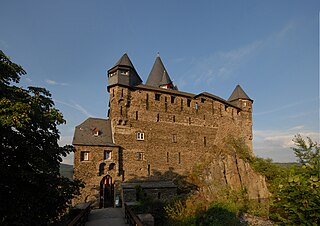
A shield wall, also shield-wall or Schildmauer, refers to the highest and strongest curtain wall, or tower of a castle that defends the only practicable line of approach to a castle built on a mountain, hill or headland. German sources may refer to a shield wall that protects two or more sides as a Hoher Mantel or Mantelmauer, which is variously translated as "mantle-wall", "mantle wall" or "high screen-wall". There is often no clear, definitive distinction between a shield wall and a mantle wall.
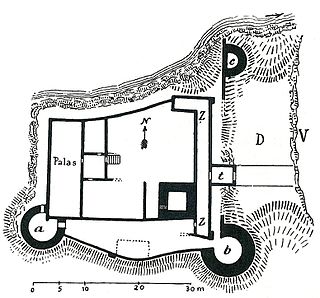
A neck ditch, sometimes called a throat ditch, is a dry moat that does not fully surround a castle, but only bars the side that is not protected by natural obstacles. It is often an important element in the defensive system of hill castles, especially in Germany and other parts of Central Europe.

The rock castle of Neudahn, in the southwestern Palatine Forest in the German state of Rhineland-Palatinate, is located at the northern end of an elongated ridge near the town of Dahn. The heart of the castle is situated on one of the sandstone rock outcrops that are typical of the Dahner Felsenland region.

A Zwinger is a German word for outer ward or outer bailey. It represents an open kill zone area between two defensive walls that is used for defensive purposes. Zwingers were built in the post-classical and early modern periods to improve the defence of castles and town walls. The term is German and usually left untranslated. However, it is sometimes rendered as "outer courtyard" presumably referring to the subsequent role of a Zwinger as a castle's defences became redundant and it was converted into a palace or schloss, however, this belies its original purpose as a form of killing ground for the defence. The word is linked with zwingen, "to force", perhaps because the Zwinger forced an enemy to negotiate it before assaulting the main defensive line. Essenwein states that the "main purpose of this feature was so that the besieging force could not reach the actual castle wall very easily with battering rams or belfries, but had to stop at the lower, outer wall; also that two ranks of archers, behind and above one another, could fire upon the approaching enemy"

The roundel is a strong artillery fortification with a rounded or circular plan of a similar height to the adjacent defensive walls. If the fortification is clearly higher than the walls it is called a battery tower.
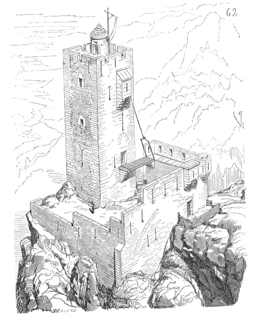
A tower castle is a small castle that mainly consists of a fortified tower or a tower-like structure that is built on natural ground. It is thus different from the motte-and-bailey castle, which it may resemble, but whose main defensive structure is built on a motte or artificial hill. The tower castle is occasionally also described as a tower house castle or a tower house.

A Landesburg or landesherrliche Burg was a castle that a territorial lord, such as a prince-bishop, duke or prince built for the defence or expansion of his sovereign estates. They were thus the central and most important castles of the great princely territories. The Landesburgen were usually the property of the territorial lord, but they sometimes referred to castles that he did not own, but were available to him as a safe house (Offenhaus). The large castles of the 8th to 10th centuries, east of the Rhine and outside the towns were often described as Landesburgen because they performed important functions in the control of the state.

Counter-castles were built in the Middle Ages to counter the power of a hostile neighbour or as a siege castle, that is, a fortified base from which attacks could be launched on a nearby enemy castle.
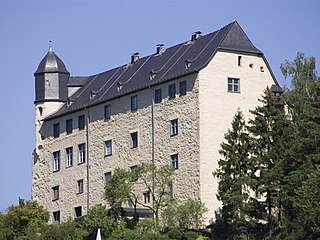
Schadeck Castle is a counter-castle which was built in opposition to the nearby Runkel Castle. It stands above the River Lahn in the eponymous parish in the county of Limburg-Weilburg in the German state of Hesse.

The Brömserburg is located near the banks of the Rhine in the town of Rüdesheim am Rhein in Rheingau-Taunus-Kreis in the German state of Hesse. Its original structure was probably one of the first stone castles in the Rhine Gorge, now a UNESCO World Heritage Site.



















